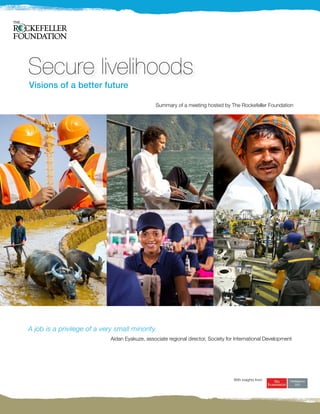The Rockefeller Foundation hosted a meeting with OECD to address global livelihood challenges, emphasizing the need for innovative strategies to boost economic resilience and inclusion in the face of technological change, demographic shifts, and climate-related issues. Key solutions discussed included leveraging technology for lifelong learning, creative financing for skill development, government safety nets, and cross-sectoral collaboration to support underserved populations. The meeting brought together over 25 experts to identify strategies for adapting to the evolving landscape of work and securing better livelihood opportunities for all.














![15Secure Livelihoods
Jobs are about
more than meeting
our needs, they
bring meaning
[and] anchor social
stability.
Adrian Wooldridge,
management editor at
The Economist
But as technology takes some jobs away, it also opens the door to others. Technology’s
potential to drive livelihoods growth was explored in two papers produced by The
Rockefeller Foundation and distributed prior to the meeting.
Job Creation Through Building the Field of Impact Sourcing describes the potential
to exponentially grow business-processing outsourcing opportunities for those at the
bottom of the pyramid in Africa, particularly disadvantaged youth, with examples of
successful ”impact sourcing” (IS) initiatives in India, South Africa and Kenya, based
on different business models. Data suggests that incomes for IS employees can rise
as much as 200%.
Digital Jobs in Africa explores opportunities for jobs based on telecommunications
and technology advances in Africa for high-potential youth in six African countries.
Even a 10% increase in telephone, mobile phone, Internet and broadband use in the
developing world can boost a country’s gross domestic product by up to 1.38%,
according to the World Bank. Because 60% of Africa’s unemployed are youth,
technology offers great promise. For a sense of the opportunity, look to Ghana. Youth
who work in the country’s IT Enabled Services Secretariat program earn more than
five times the minimum wage.
As this research shows, technological innovation coupled with the right training for
workers will open new doors to high-quality jobs in industries ranging from technology
to health and clean energy. Some believe innovation has lagged in recent years due to
shrinking corporate budgets in the wake of the global recession and social protests,
such as the anti-GMO movement in Europe. But others foresee an innovation wave,
fueled by breakthroughs in artificial intelligence and robotics. With the right mix of
incentives and collaboration, they argue, the benefits will help boost even unskilled
livelihood possibilities and quality of life across the globe.](https://image.slidesharecdn.com/securinglivelihoods-141219074417-conversion-gate02/85/Securing-Livelihoods-15-320.jpg)








![24 Secure Livelihoods
and learning centers where individuals can build community, collaborate and
contribute toward work for all. Volunteer work options, in which individuals
receive government subsidies for some social contribution to society, may
include planting village gardens, improving infrastructure, restoring ecosystems,
tutoring or launching job-creation schemes.
“We envision a marketplace ranging from paid internships to private-sector jobs to
paid students, with the government running a portfolio of pro-bono contributions
and safety nets, in conjunction with community centers and incubators,” said
Vijay Vaitheeswaran of The Economist. “Everyone who wants to work can, and
meets [his or her] basic needs. “There are more paths to work than being paid.”
4. Cross-sectoral collaboration to formalize the informal and share its
benefits. The centralized nature of cities helps pool resources and opportunity
for large, diverse and dense populations. But this concentration can also seed
inequality, because all too often the poor and vulnerable are left with fewer
resources, rights and opportunities to make a living than formal settlements with
formal workforces. “How can we tackle the root causes of urban migration? How
do we eliminate or reduce stress migration?” asked Asher Hasan, founder of
Naya Jeevan. “We want to provide rural migrants a path to property rights and
sustainable livelihoods.”
In this regard, a number of new tools and approaches are now available to
communities of all means to help them on their path toward legitimacy, social
protection and opportunity. These include technology, legislative developments
and community organizing. The ”Live it up” working group solution builds
on these elements, with technology as its cornerstone—in a mobile platform,
software and tablets.
One possible solution may involve an “urban passport,” through a universal,
electronic identification card guaranteeing basic rights such as access to
education and healthcare, which brings protection in key areas including property
ownership. Over time, such a card could be used to build financial inclusion
through mobile banking services. By focusing on slums, the flow of migration from
rural areas to cities may recede, and better-paid opportunities and protection in
informal settlements may take root. “Livelihoods have two elements: income and
what you do it for,” said Conal Smith, section head, well-being and household
conditions, at the OECD. “If urbanization is losing your community then there is
a trade-off.”
FUTURESOLUTIONS](https://image.slidesharecdn.com/securinglivelihoods-141219074417-conversion-gate02/85/Securing-Livelihoods-24-320.jpg)



